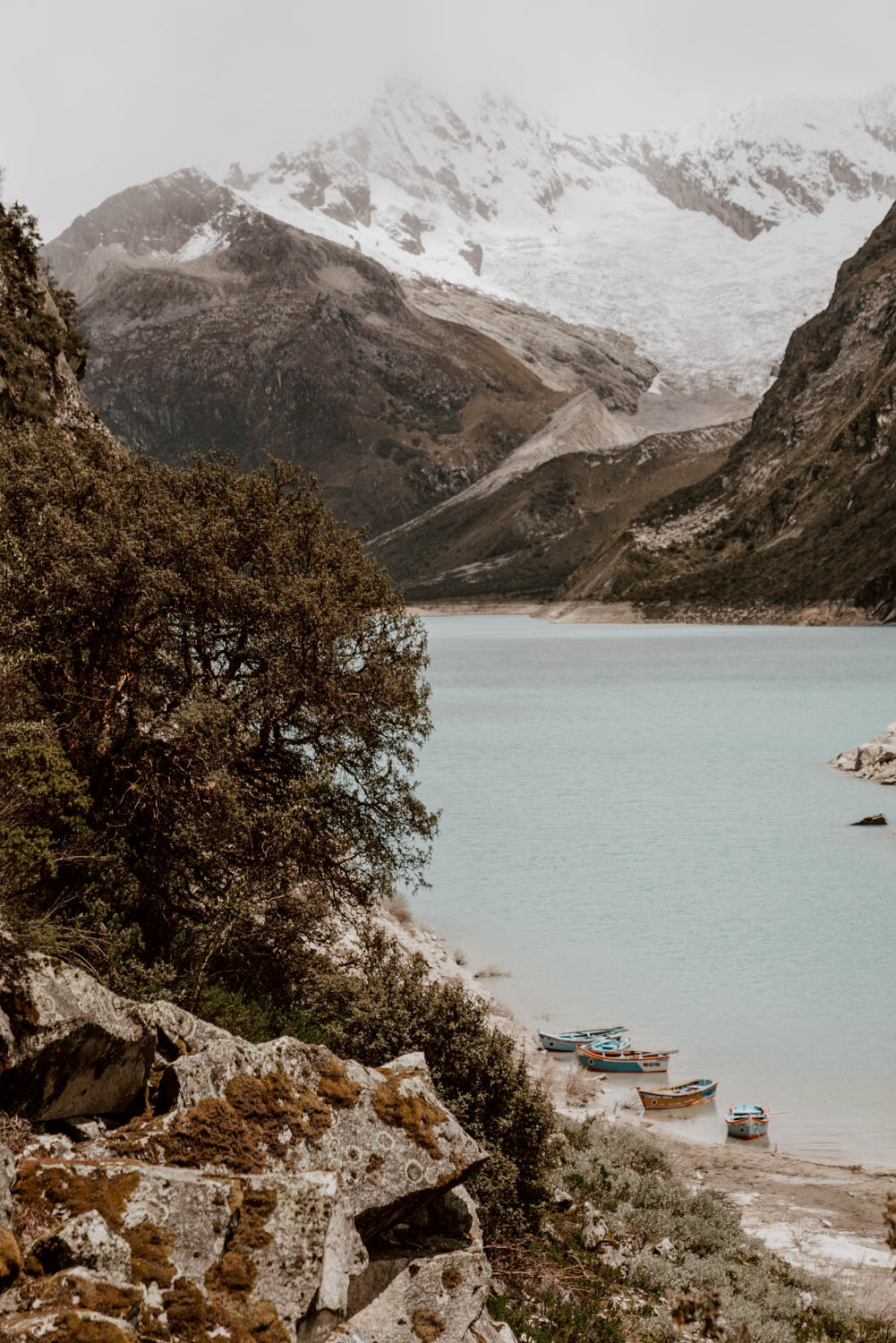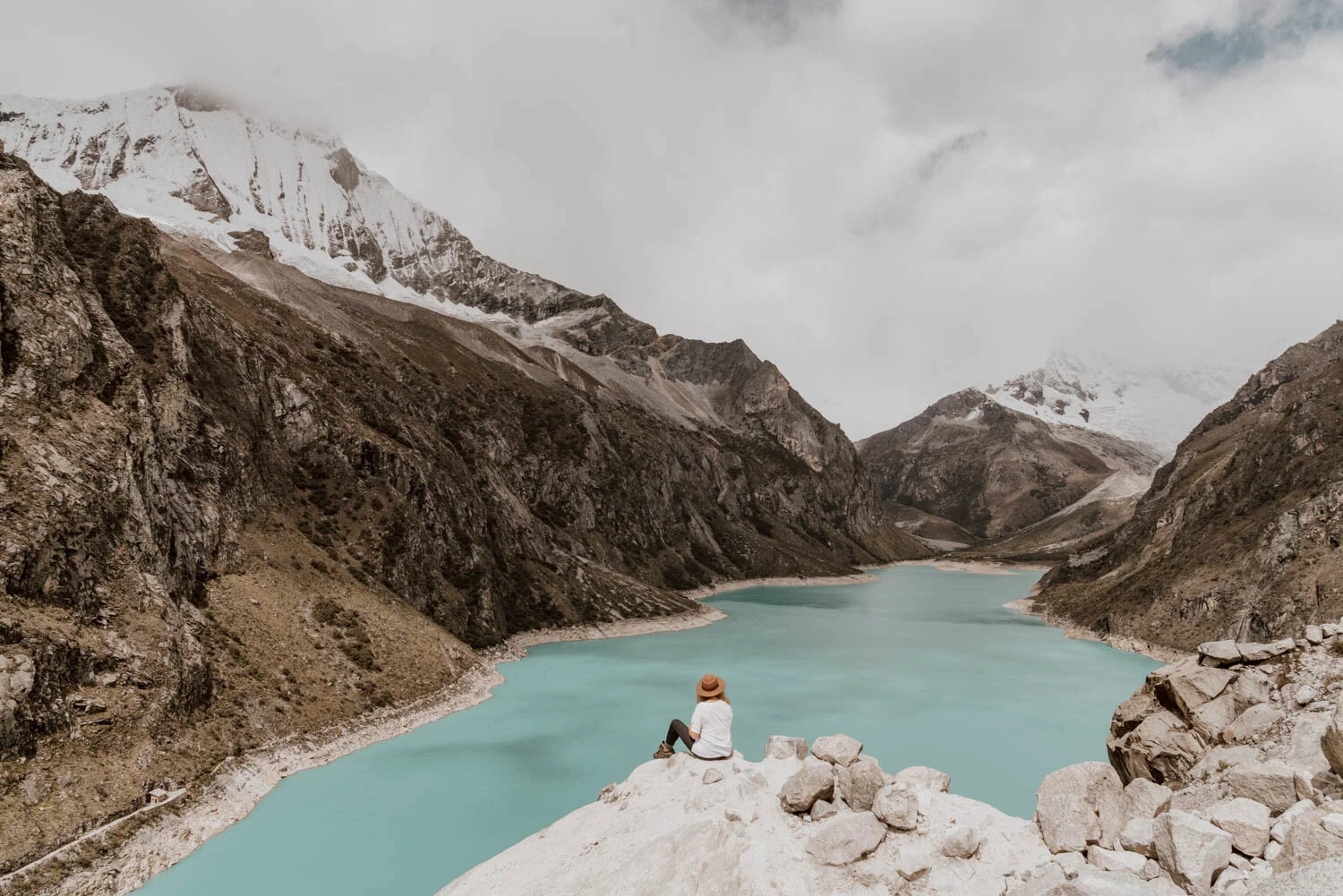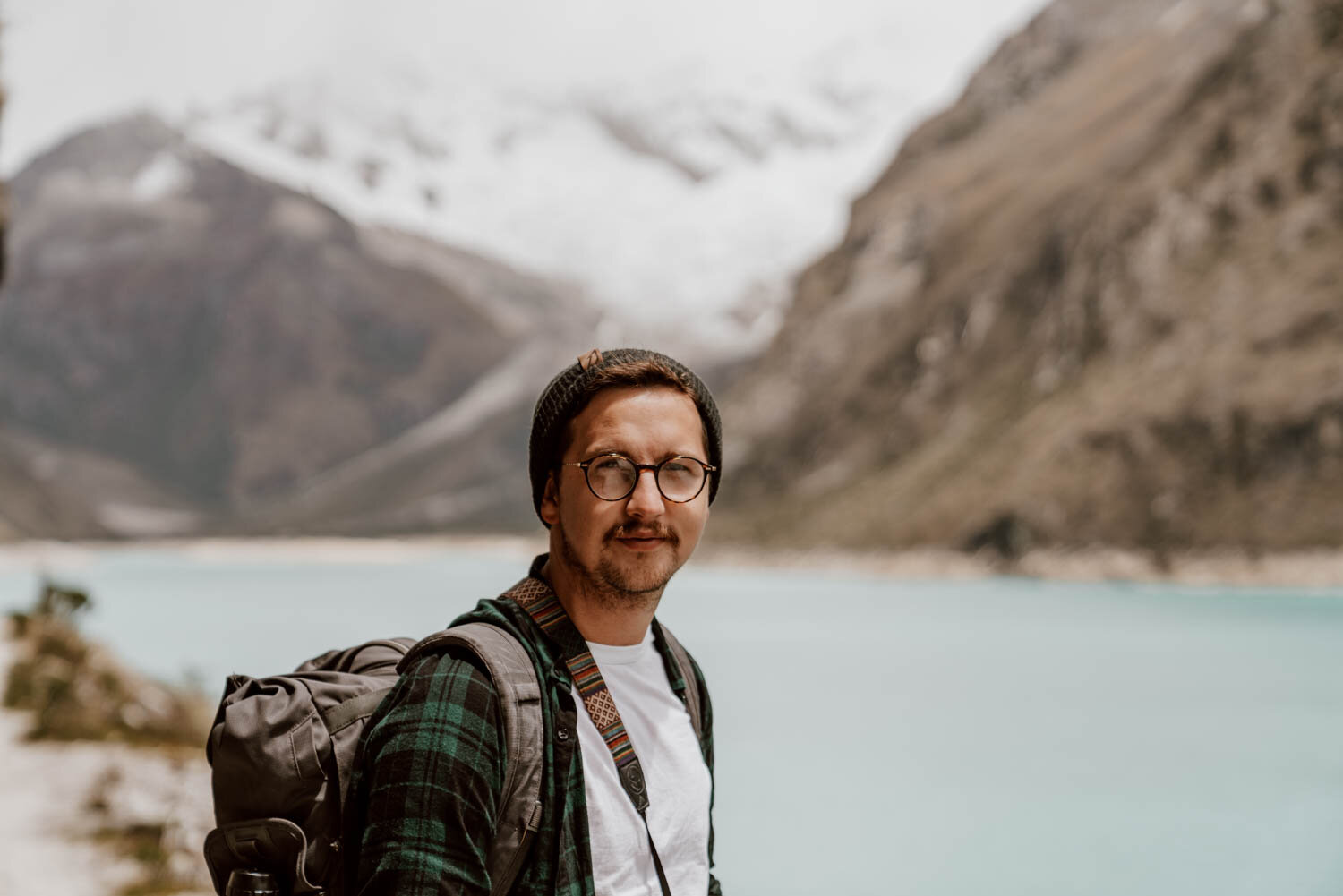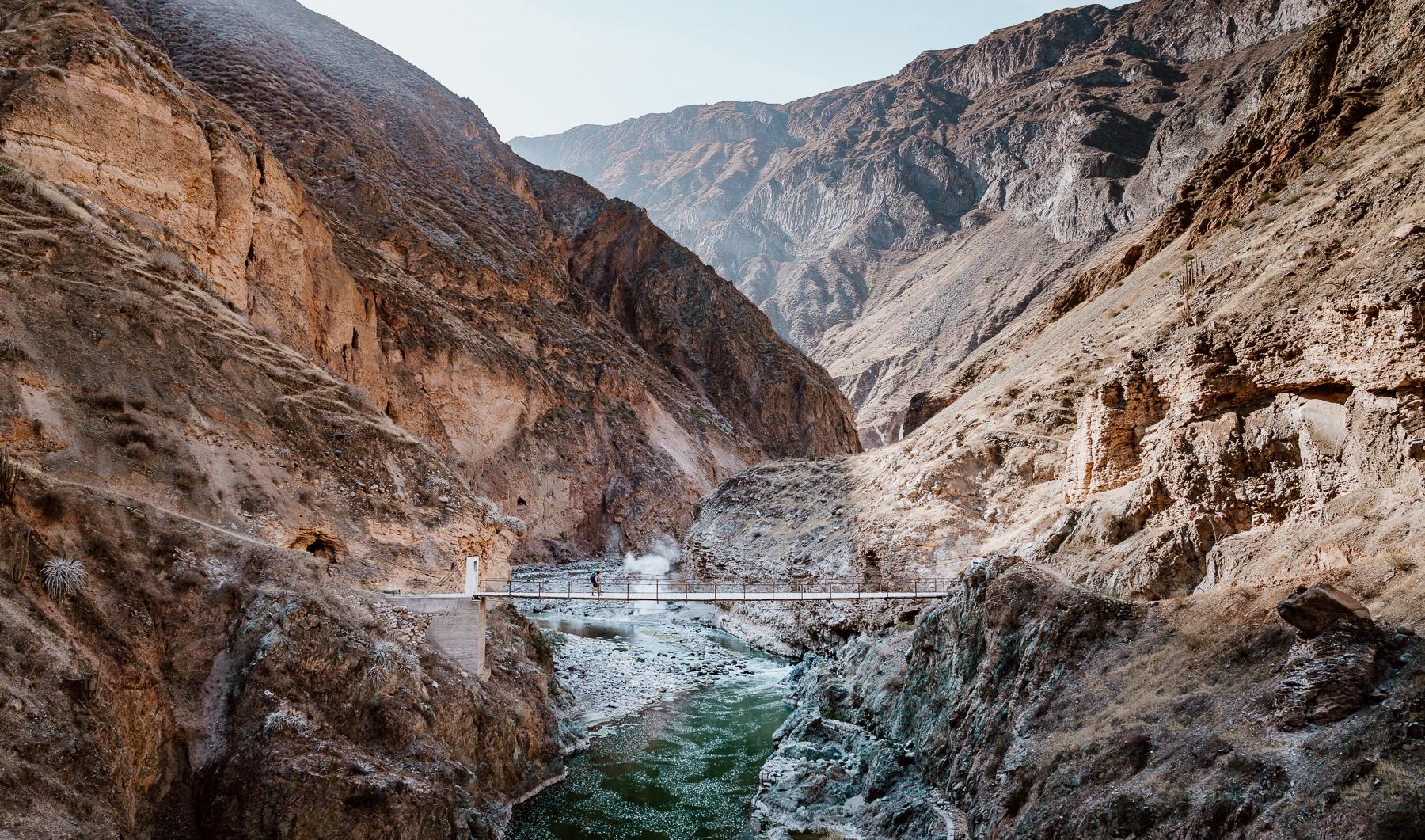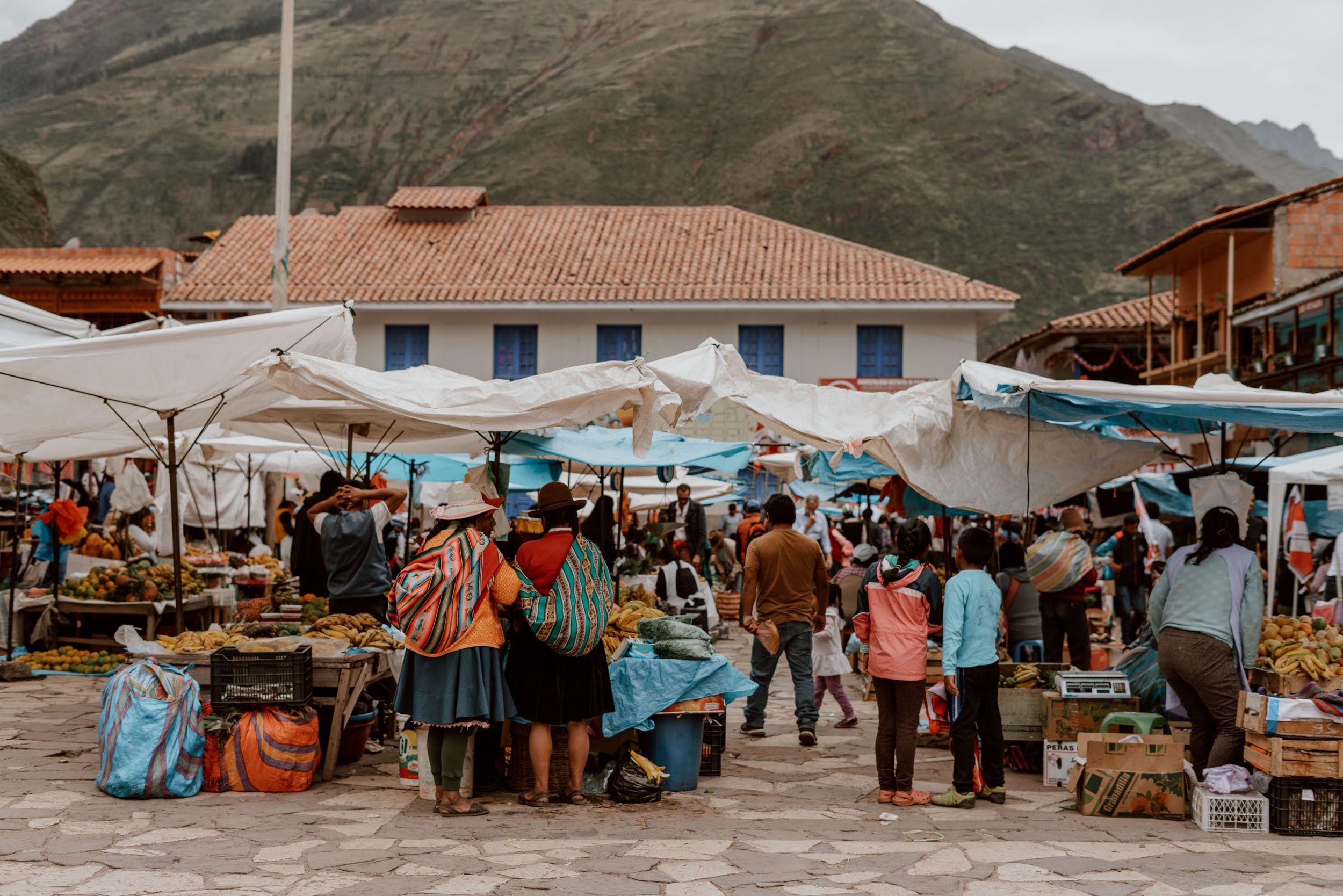Updated January 2024
If you’re planning on visiting Huaraz - hell, even if you’re not - you absolutely need to visit Laguna Paron. The largest lake in the Cordillera Blanca, it’s also one of the most beautiful. In this guide you’ll find everything you need to know to plan the perfect trip including how to get there (with and without a tour), things to do in Laguna Paron, what to pack and a handful of super helpful tips.
We like to think we’re somewhat immune to the follies of instagram and planning trips based solely on a single beautiful photo.
But then we saw a photo of Laguna Paron. And well, yeah, we didn’t stand a chance.
Having visited the increasingly popular Laguna 69 last time we were travelling in Huaraz, we didn’t expect to find another glacial lake quite so beautiful. However, an easy day-trip out to Paron persuaded us that when it comes to impossibly gorgeous and impossibly blue lakes, the north of Peru really does have the best in South America.
In this post, we’ll share all the key information on how to do a day trip to Laguna Paron (with a tour or independently), plus advice on how to make the most of your time at the lake.
Laguna paron essentials
Altitude // The mirador over the lake sits at 4,200m, the lake itself a little lower. Yep, this is really quite high
Distance // If you choose to hike from the trailhead entry, the total distance is approximately a 20km round trip. Should you take a tour that goes all the way to the lake entrance, you need only do a short walk (45 minutes there and back) up to the mirador.
Time // This is a long day trip from Huaraz, requiring a start at either 5 a.m. or 8 a.m. dependent upon the type of tour you take. Tours are usually back in Huaraz by about 6 p.m.
Base City // Huaraz. Sosa House Eco Hotel Boutique and Huaraz Colonial are two excellent places to stay.
Our guide to Laguna Paron | A Spectacular Day Trip From Huaraz
ALTITUDE SICKNESS AND ACCLIMATISATIOn
Throbbing headache, loss of appetite, nausea, lethargy, altered sleep patterns, shortness of breath.
Also known as altitude sickness, the above are a set of symptoms that the human body can experience once passing beyond 2,500m. This is when the the air gets thinner, oxygen levels decrease and - for those not used to being at higher altitudes - your body tries to tell you that it’s not okay with that.
Usually not something many of us need to worry about, but in South America, a part of the world where there are countless mountains, lakes and even cities at heights that dwarf many of Europe’s highest peaks, higher altitudes and the potential effects of being at them are something that you will need to not only be aware of, but prepare for - in a process called ‘acclimatisation’.
And that’s exactly why when arriving in Huaraz - which is already at 3,000m - from near sea-level, you will need at least one full day of just hanging out in the city before attempting to visit Laguna Paron.
Sitting at 4,200m, this lake’s altitude is no joke, and will feel utterly horrendous if you’ve only arrived from Lima the previous day. This includes visiting independently, as well as part of an organised group - don’t assume that simply because the tour requires minimal exertion that you needn’t worry.
Trust us, we’ve seen people attempt high-altitude hikes within a day of arriving into Peru. It’s not pretty, they rarely make it to the end, and they feel crappy for another few days; your body needs to get used to simply functioning on less oxygen, before you ask it to go any higher.
If you’re not exploring much of the Cordillera Blanca whilst in Huaraz, this hike will likely be a real highlight, so acclimatise and then enjoy.
Want to know more about altitude sickness in Peru and how to prevent it? See this post.
how to visit laguna paron With a Tour
Laguna Paron is one of the lesser visited lakes in the area, but even in the lowest of low season, finding a tour is relatively easy. The important thing to note is that there are two distinctly different tours on offer at hostels and agencies in Huaraz; one that departs at 5 am and includes a three hour hike to the lake’s edge (and includes either the Huandoy Viewpoint or Artesonraju Mountain) and another that departs at 8 am and delivers you by bus straight to the lake.
We had initially wanted to do the tour that involved the hike (if you’re not sweating by the time you reach some spectacular destination in the mountains, have you really deserved it?), but as it was the December low season there simply wasn’t enough interest for an early morning tour to leave. In high season (May-September), the situation may be different so it’s worth asking around town.
Instead, we had to opt for the tour arranged by our hostel which departs at 8 am and is the most popular option.
The guided tour itself takes 9.5 - 10 hours, but the vast majority of that is spent driving:
Departing Huaraz at 8 am, you’ll travel 45 minutes to the small town of Carhuaz - famed for its ice cream - with a 30 minute stop to pick up snacks
Back in the van, then it’s 45 minutes to Caraz, passing through Yungay, the small town utterly decimated by a 7.9 magnitude earthquake back in the 70s.
From Caraz, it’s further two hours along a very very bumpy and winding dirt road to the lake, stopping after one hour to pay the S/. 5 entry fee (around $1.50)*
Once you’re at lake, you’ll be given two hours to explore the area independently (you can find more information below on the things to do in at Laguna Paron)
It’s then back in the bus for the two hour journey back to Caraz, when you’ll be given the chance to get out, stretch your legs and perhaps indulge in sweet alfajores (the town is apparently famous for them)
Final leg of the journey back to Huaraz takes 1.5 hours, during which time most of you will be fast asleep!
It’s a long drive there and back, so make sure you’ve got some podcasts or music downloaded!
The Laguna Paron tour costs around about S/. 70 (approx $18 USD) per person depending upon which company you go with (although we have heard of some agenices charging up to $35 USD).
Alternatively, if you’re only in Huaraz for a short while and wish to arrange your tour in advance, this is a highly-rated option. It’s more expensive than arranging it in person, but if you’re on a tight itinerary or are the sort of person who likes to be organised in advance, it may be a good option.
Request | If you find when you visit that the entry fee or cost of a tour has increased, we’d love if you could leave a comment so we can keep the guide up to date. Cheers.
How to Visit Laguna Paron Without a Tour
There is little doubt in our minds that visiting Laguna Paron independently is by far the best way to enjoy it; not only are you free to enjoy it for longer, you will avoid the worst of the crowds (that tend to descend in relatively large numbers from 12 pm in the higher season), and the view from the mirador will be all that sweeter after a decent hike.
However, it’s important to note that whilst visiting without a tour is absolutely possible, to do so requires three things: a sense of adventure, little bit of planning, a fair bit of luck!
You see whilst getting there is relatively straightforward (providing you don’t mind a super early wake up), it’s the getting back to Huaraz that can cause a few more problems, with the route from the lake to the town of Caraz - where you change collectives - prone to unreliable timetables and inconsistent information.
Below we have outlined how to get to the trailhead with public transport, a little about the hike to the lake, as well as getting back:
Take the first collectivo from Huaraz to Caraz, which takes around 1.5 hours and leaves at 5 am.
Transfer to the first colectivo from Caraz to Pueblo Paron, which leaves at 6.30 am from the Terminal Terrestre, with other early morning departures. Costs S./10 per person. Alternatively, you could higher a taxi for S./120 who would drive you there and back, with a two hour waiting time.
The collectivo will drop you in Pueblo Paron a small village just a five minute walk from the trailhead.
From here, you have two choices: follow the dirt road that colectivos take, or take the hiking trail, which although 10 km long is significantly shorter than the road. This is well-signposted and only occasionally crosses the road. As there is some gain in altitude, expect to spend three hours hiking up.
You will arrive at Laguna Paron before the tour groups descend, and therefore have plenty of time to enjoy the tranquil surroundings by yourself. We had two hours at the lake but could easily have spent longer.
The hike back to the colectivo pick up point in Pueblo Paron takes only two hours as it is mainly downhill.**
You will need to ensure you set off with enough time to make the last colectivo to Caraz. This is said to be 5 pm, but has been known to arrive at 4.30 pm, or - in the case of several travellers - not at all.
From Caraz to Huaraz, there are semi-regular colectivos, although you may need to wait for them to fill up.
Having read stories of others giving up and attempting to flag down a passing car, it was the unreliability of the colectivo from Pueblo Paron to Caraz which finally convinced us to opt for a tour to Laguna Paron. Whilst we were pretty certain we could have gotten there and back independently - wherever you are going in Peru, there is always a colectivo - but the issue is whether it aligns with the time that you’re back in Pueblo Paron - the risk of being stranded at 4,200m in torrential downpours didn’t seem like the most exciting prospect.
Do note that, after much discussion between ourselves, we actually think that doing the trip to Laguna Paron as an independent day trip from Huaraz doesn’t make the greatest amount of sense due to the distances involved. Instead, you’d likely being better getting accommodation for the night in Caraz and setting off on the first collectivo from there.
Should you choose to stay in Caraz, Yoly's House and Hostal y Restaurante Business Rosh both have excellent reviews.
**Do note that it is sometimes possible to grab a lift back to Huaraz directly from Laguna Paron with one of the tours. One of our lovely readers managed to do this, negotiating a rate of S./15.
Alternative Option // If you’re wanting to head out to Laguna Paron with a group, another option is to take a private taxi to and from Huaraz. Expect to pay around $150 USD.
Things to do in Laguna Paron
Hike to the Mirador
Standing at the water’s edge, there is little doubt that this is one seriously pretty lake; head up to the mirador however and you will be blown away by the snow capped peaks and spectacular views out over the aquamarine waters (that extra 300m up there makes all the difference in terms of views!)
As tours somewhat limit your time at the lake, be sure to factor in an hour to get up and down from the mirador (that’s one hour total) as well as photo time. Do note that although there is a path for the majority of the ascent, once it begins to flatten out, the dirt path turns into giant boulders than require much more scrambling than walking - definitely make sure you have good footwear for this hike and stay away from the bloody edge!
Top Tip // If you’ve visiting as part of a tour, they will usually head to the mirador first - so we’d absolutely recommend that you don’t join them. Instead, check out some other parts of the lake and let the groups dissipate. We promise, it’s worth the wait and nobody else being around taking photos.
Take a short walk along the lake’s edge
To the left of the small beach, there’s a walkway that snakes along the edge of the lake for about twenty minutes, providing views not accessible from the main mirador.
Do note that you are unable to walk the edge of the lake in its entirety, and parts of the path become a little sketchy towards the end - be careful with your footing.
Head out on to the Water
If you have a little time after snapping away and hitting up the mirador, consider taking one of the row boats or kayaks out on to the water. Nothing like paddling across a glacial lake!
Kayaks are S/. 20 per person and row boats are S/. 10 per person. Just make sure you don’t misjudge the time and end up stranded in the middle of the lake as your tour gets ready to head back to Huaraz…
Spend the night at laguna paron
Possibly one for the more hardy amongst you, but it is possible to spend the night at Laguna Paron. The visitor’s building that houses the toilet (S/. 1 to use), also has a couple of very basic shared dormitories with bunk beds that you can rent for the night (S/. 20 per person).
If you are happy to source your own transport to and from Caraz, this would definitely allow you to enjoy the lake without another soul present.
The hardier amongst you can also camp there, either with your own tent or rent one from the little office. Tents cost S/.30 each.
Update // A reader who recently did this has advised that should you choose to spend the night at the refugio, you should consider bringing a sleeping bag with you or rent one there for S/.20). There are heavy blankets, but during the colder months this may not be enough. Additionally, a whilst there is some electricity, a headlamp was invaluable, and you are able to use the on-site kitchen to cook a meal at night.
Things to Know Before Visiting Laguna Paron
Even if you go on an organised tour to Laguna Paron, there are a few things you can know or do that will ensure you have the absolute best time possible at the lake:
// Take snacks. With lunch time falling at exactly the moment you arrive at the lake, you don’t want to waste valuable exploration time wolfing down sandwiches (unless you already made them back at the hostel, smarty pants!). Additionally, there is nowhere to really source food at the lake bar the one or two local ladies selling a basic plate of food (nothing veggie that we were aware of). As ever, bring enough water to counter the altitude and remain hydrated. We highly recommend buying a travel filter water bottle for your South America adventures you can read all about them, and our top picks in our guide.
There are a few brands on the market, but we personally use and recommend Water-to-Go. You can buy these on the official website - be sure to use the code ‘ADR15’ to get 15% off at checkout.
// The weather can be very temperamental. We had thick fog, heavy rain, strong winds and clear blue skies - all in the space of two hours. This high up, things change very quickly, so if the picture perfect scene isn’t there when you arrive, give it time.
// Wear the right clothing. When we got dressed on the morning of our tour, we weren’t entirely sure what to wear. Was full-on hiking gear a little excessive for a day that involved minimal hiking? We decided to go for it anyway, and boy were we glad we did. Waterproof jackets protected us when the weather turned and solid hiking boots meant we didn’t twist an ankle getting to the mirador.
// Tours will usually pick you up from your hostel, so be aware that the first 30-45 minutes of the tour will involve driving around Huaraz. Make sure you’re on time, as it’s never fair to make the rest of your tour wait around.
// Keep change for the entry fee. No tour will cover the S/. 5 entry fee, and, if you’re already in Peru, you’ll know that nobody has change - for ease, it helps to be prepared.
// There are bathrooms at the lake, cost S/. 1 per person. Toilet roll is provided (it always makes sense to keep some in your daypack in Peru anyway) but bring hand-sanitiser.
WHAT TO PACK
As with any hike, anywhere in the world, it’s imperative that you embark upon it prepared for - almost - any eventuality, and with the right type of kit. If you’re hiking independently from Pueblo Paron that means full-on hiking gear, but even joining a tour like we did, appropriate outdoor clothing is necessary.
Of course, you don’t need the fanciest of clothing or the most expensive boots, but there are some items that every smart hiker will have in their kit.
// Good hiking shoes. Mud, snow, rocks, uneven terrain and the odd unexpected hole in the ground means that good hiking shoes (ideally boots like these) are absolutely essential, especially if you plan on heading up to the mirador - which you absolutely should do. We both lost our footing a couple of times, and were it not for the good ankle support of a decent pair of boots, we could have done ourselves some mischief.
// Charged Phone. These are popular hikes, and even if you’re not undertaking them as part of a tour, there will usually a few people around. However, things can, and do happen, and should you get unlucky, stranded, or injured, having the ability to call for help is very important - you may not always have signal, but we often had the odd bar of reception on various sections.
If you phone battery can’t be relied upon, consider investing in a portable charger - we use this one. As mentioned, you’ll be spending a lot of time on transport - you can make it pass a little with podcasts, music etc.
Additionally, it’s useful to have an offline version of a map of the area, hopefully with the route on. If you’re not sure how to do this, see our helpful guide.
// Layers. Even if you’re visiting during the drier months of the year, the weather in here can be a tad unpredictable - and layers will be your friend. We began the day rugged up with countless layers, needing to strip back a little as we - and the weather - warmed up. Oh, and we really appreciated our Merino wool under layers for extra protection from the cold.
// Waterproof Jacket. When the heavens opened during our walk around the lake, we were very glad to have our waterproof jackets. They’re breathable, windproof, lightweight and bright enough that even in a rain storm we could usually spot one another.
// Hiking Poles. Whilst we did have a collapsible set of travel hiking poles snaffled away in our backpacks, we didn’t need to take them out at Laguna Paron. With that said however, if you have bad knees or would prefer a little support, then it’s sensible to bring a set.
// A Head Torch. Should everything go to plan, this should never need to be used. If on the other hand you get a little lost or take a little longer and the sun begins to go down, you’ll be glad to have a light source to guide the way.
// A Small First Aid Kit. Again, hopefully you’ll never need it (most tour buses also have their own small kit) but having a few supplies in case something bad happens is always a good idea. Ours certainly came in handy when Emily got bit by a stray dog 25km into a 30km hike.
// Leave No Footprints. Remember to respect the location, and discard of any litter appropriately.
// A Camera. Honestly, this lake is so incredibly stunning, you’re going to want to photograph every inch of it! Find out what’s in our camera bag.
// Travel Insurance. Most travel insurance policies exclude cover for activities at high altitude - which means that as standard, if anything was to happen whilst you were exploring Laguna Paron, the Huascarán National Park - or possibly even the city of Huaraz - you may be screwed should anything untoward happen. It’s therefore essential that you ensure yours is up to scratch for your South America trip - we use True Traveller which offers extra coverage options for high altitude hikes.





